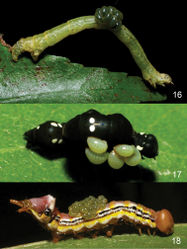Euplectrus sydneycameronae
| Notice: | This page is derived from the original publication listed below, whose author(s) should always be credited. Further contributors may edit and improve the content of this page and, consequently, need to be credited as well (see page history). Any assessment of factual correctness requires a careful review of the original article as well as of subsequent contributions.
If you are uncertain whether your planned contribution is correct or not, we suggest that you use the associated discussion page instead of editing the page directly. This page should be cited as follows (rationale):
Citation formats to copy and paste
BibTeX: @article{Hansson2015ZooKeys, RIS/ Endnote: TY - JOUR Wikipedia/ Citizendium: <ref name="Hansson2015ZooKeys">{{Citation See also the citation download page at the journal. |
Ordo: Hymenoptera
Familia: Eulophidae
Genus: Euplectrus
Name
Euplectrus sydneycameronae Hansson sp. n. – Wikispecies link – ZooBank link – Pensoft Profile
Material
Holotype a female labeled “ COSTA RICA: Alajuela, ACG, Sector Pitilla, Pasmompa, 15.x.2007, P. Rios, ex Plusiodonta clavifera eating Cissampelos tropaeolifolia, sibling of wasp DHJPAR0028936, 07-SRNP-33543” (BMNH). PARATYPES: 5♀ 1♂ with same label data as holotype (BMNH, INBio, USNM).
Diagnosis
Lower face entirely yellowish-brown (female, as in Fig. 394) or white (male, as in Fig. 395), pale part not reaching hypostomal carina and with area close to mouth cavity dark (as in Fig. 581); fore coxa yellowish-white, remaining fore leg and mid and hind legs yellowish-brown (as in Fig. 393); petiole 1.0× as long as wide; gaster dark brown, anterior ½ yellowish-white (female, as in Fig. 396) or white (male, as in Fig. 397) with dark brown lateral margins; male antenna with scape slightly expanded and widest in the middle, 2.6× as long as wide (as in Fig. 399), flagellomeres 2–5 with a basal whorl of erect setae.
Description
Female. Length of body 2.3 mm. Antenna with scape yellowish-white, pedicel yellowish-brown, flagellomere 1 yellowish-brown, 2 pale brown, 3–6 dark brown (as in Fig. 398). Mandibles and palpi yellowish-white. Head black and shiny, entire lower face yellowish-brown with median part darker (as in Fig. 394). Frons close to eyes with two rows of setae (as in Fig. 404). Vertex smooth (as in Fig. 405). Occipital margin rounded (as in Fig. 405).
Mesosoma black and shiny (as in Fig. 393). Each sidelobe of mesoscutum with 20 setae. Scutellum 0.9× as long as wide; with very weak engraved reticulation (as in Fig. 406). Dorsellum along anterior margin with a very narrow groove (as in Fig. 767), medially 0.1× as long as length of dorsellum. Propodeum with very weak reticulation (as in Fig. 767); anteromedially with a semicircular cup that has posterior part strongly raised and is distinctly higher than anterior part; propodeal callus with eight setae. Legs (as in Fig. 393): fore coxa yellowish-white, remaining fore leg and mid and hind legs yellowish-brown. Fore wing: costal cell on ventral surface with two rows of setae in basal ⅔ and one row in apical ⅓, and margin with four setae close to marginal vein; with 16 admarginal setae, in one row.
Gaster dark brown, anterior ½ yellowish-white with dark brown lateral margins (as in Fig. 396).
Ratios. HE/MS/WM = 2.1/1.0/1.4; POL/OOL/POO = 4.9/2.9/1.0; OOL/DO = 1.4; WE/WF/WH/HH = 1.0/2.5/4.5/3.2; WH/WT = 1.1; PM/ST = 1.6; TS1/TS2/LT/LT1/LT2/LT3/LT4 = 4.0/2.4/6.4/2.0/1.7/1.0/1.7; LP/WP = 1.0; MM/LG = 1.0.
Male. Length of body 1.9 mm. Scape slightly expanded and widest in the middle (as in Fig. 399), sensory pores confined to apicoventral ¾, sensory area pale as scape. Otherwise similar to female except flagellomeres 2–5 with a basal whorl of erect setae (as in Fig. 399); entire lower face white (as in Fig. 395); scutellum with posterior ¼ smooth; gaster shorter and with pale part white.
Ratios. LC/WS = 2.9; MM/LG = 1.2.
Hosts and biology
Feeding on penultimate instar of Plusiodonta clavifera (Erebidae) feeding on Cissampelos tropaeolifolia (Menispermaceae), parasitoid cocoons stuck to dead larva and substrate.
Distribution
Costa Rica (Alajuela Province).
Etymology
This species is named after Sydney A. Cameron, in recognition of her contribution to the understanding of ACG Hymenoptera taxonomy.
Remarks
This species is morphologically identical to Euplectrus johnnoyesi, but the barcode is significantly different from this species, it is 5% divergent from Euplectrus johnnoyesi within the barcode region (24–32 bp (& 1 amino acid) different) (Fig. 35, Suppl. material 1), and also the host is different. In spite of the morphological similarity we therefore regard these as two different species.
Original Description
- Hansson, C; Smith, M; Janzen, D; Hallwachs, W; 2015: Integrative taxonomy of New World Euplectrus Westwood (Hymenoptera, Eulophidae), with focus on 55 new species from Area de Conservación Guanacaste, northwestern Costa Rica ZooKeys, (485): 1-236. doi
Images
|
Other References
- ↑ Saitou N, Nei M (1987) The neighbor-joining method: A new method for reconstructing phylogenetic trees. Molecular Biology and Evolution 4: 406–425.
- ↑ Kimura M (1980) A simple method for estimating evolutionary rate of base substitutions through comparative studies of nucleotide sequences. Journal of Molecular Evolution 16: 111–120. doi: 10.1007/BF01731581
- ↑ Tamura K, Stecher G, Peterson D, Filipski A, Kumar S (2013) MEGA6: Molecular Evolutionary Genetics Analysis version 6.0. Molecular Biology and Evolution 30: 2725–2729. doi: 10.1093/molbev/mst197

![Figure 35. Interspecific variation of DNA barcodes among species of ACG Euplectrus displayed using the Neighbor-Joining method (Saitou and Nei 1987[1]) with distances computed using the Kimura 2-parameter method (Kimura 1980[2]) conducted in MEGA6 (Tamura et al 2013[3]). When there was more than one sequence available for each species, the representative sequence was selected based on quality (longest read length with the fewest ambiguities). Line labels are the voucher code|species name|host family|number of barcoded specimens in the ACG database at the time of writing. In the two cases where two species have nearly identical barcodes, morphological differences suggest that each pair indeed contains two species, the veracity of which will be the subject of further research when more samples are available.](https://species-id.net/o/thumb.php?f=Zookeys-485-e4835-g011.jpg&width=205)



